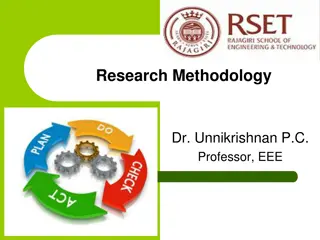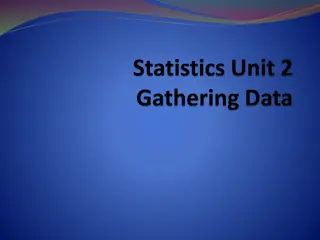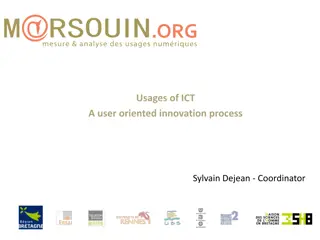Developing Effective Questionnaires for Research Studies
Crafting a well-designed questionnaire is crucial for gathering accurate data in research projects. Explore various data collection methods, primary and secondary data collection techniques, qualitative and quantitative research methods, and the importance of data collection for making informed decisions. Learn how to create questionnaires to elicit valuable responses for your surveys.
Download Presentation

Please find below an Image/Link to download the presentation.
The content on the website is provided AS IS for your information and personal use only. It may not be sold, licensed, or shared on other websites without obtaining consent from the author. Download presentation by click this link. If you encounter any issues during the download, it is possible that the publisher has removed the file from their server.
E N D
Presentation Transcript
HOW TO CREATE A QUESTIONNAIRE? ( ?) Mr. ACM. Nafrees Instructor, FIA, SEUSL
Agenda Data Collection Methods Develop a Questionnaire for a Research Online Survey Tools for Create questionnaire Sampling methods Organized by: Student Research Forum (SRF), FIA, SEUSL, Nov 2020 2
DATA COLLECTION METHODS DATA COLLECTION METHODS Organized by: Student Research Forum (SRF), FIA, SEUSL, Nov 2020 3
Data Collection Methods & Tools For Research Data Collection Methods & Tools For Research The underlying need for Data collection is to capture quality evidence. To improve the quality of information, it is expedient that data is collected so that you can draw inferences and make informed decisions on what is considered factual. Organized by: Student Research Forum (SRF), FIA, SEUSL, Nov 2020 4
What is Data Collection? Data collection is a methodical process of gathering and analyzing specific information solutions to relevant questions and evaluate the results. to proffer key purpose to make predictions about future probabilities and trends. Organized by: Student Research Forum (SRF), FIA, SEUSL, Nov 2020 5
Type of Data Collection Primary Data Collection Qualitative research method Quantitative research method Secondary Data Collection Organized by: Student Research Forum (SRF), FIA, SEUSL, Nov 2020 6
Primary data collection: Qualitative Research Method The qualitative research methods of data collection does not involve the collection of data that involves numbers or a need to be deduced through a mathematical calculation, rather it is based on the non- quantifiable elements like the feeling or emotion of the researcher. An example of such a method is an open- ended questionnaire. Organized by: Student Research Forum (SRF), FIA, SEUSL, Nov 2020 7
Primary data collection: Quantitative Research Method Quantitative methods are presented in numbers and require a mathematical calculation to deduce. An example would be the use of a questionnaire with questions to arrive at figures to be calculated Mathematically. close-ended Also, regression, mean, mode and median. methods of correlation and Organized by: Student Research Forum (SRF), FIA, SEUSL, Nov 2020 8
Data Collection Methods 1. Interviews An interview is a face-to-face conversation between two individuals with the sole purpose of collecting relevant information to satisfy a research purpose. Structured Semi-structured Unstructured Tools Audio Recorder Digital Camera Camcorder Organized by: Student Research Forum (SRF), FIA, SEUSL, Nov 2020 9
Data Collection Methods 2. QUESTIONNAIRES This is the process of collecting data through an instrument consisting of a series of questions and prompts to receive a response from individuals it is administered to. Questionnaires are designed to collect data from a group. fixed-alternative Scale open-ended Tools: Online forms Paper Questionnaire Organized by: Student Research Forum (SRF), FIA, SEUSL, Nov 2020 10
Data Collection Methods 3. Reporting: data reporting is the process of gathering and submitting data to be further subjected to analysis. Tools NGO Reports Newspaper Website Article Hospital care records Organized by: Student Research Forum (SRF), FIA, SEUSL, Nov 2020 11
Data Collection Methods 4. Existing Data: This is the introduction of new investigative questions in addition to/other than the ones originally used when the data was initially gathered. It involves adding measurement to a study or research. An example would be sourcing data from an archive. Tool Research Journal Surveys Organized by: Student Research Forum (SRF), FIA, SEUSL, Nov 2020 12
Data Collection Methods 4. Observations: This is a data collection method by which information on a phenomenon is gathered through observation. complete observer Participants Participant as an observer complete participant. Tools Checklist Direct Observations Organized by: Student Research Forum (SRF), FIA, SEUSL, Nov 2020 13
Data Collection Methods 6. Focus Groups: Focuses more on qualitative research. Primary category for data based on the feelings and opinions of the respondents. This research involves asking open-ended questions to a group (6-10) Tools: Two-way Dueling Moderator Organized by: Student Research Forum (SRF), FIA, SEUSL, Nov 2020 14
Data Collection Methods 7. Combined Methods: This method of data collection encompasses the use of innovative methods to enhance participation to both individuals and groups. Primary category Combination of Interviews and Focus Groups while collecting qualitative data. Tools: Online Survey Dual-Moderator Organized by: Student Research Forum (SRF), FIA, SEUSL, Nov 2020 15
Organized by: Student Research Forum (SRF), FIA, SEUSL, Nov 2020 16
DEVELOP A QUESTIONNAIRE FOR A RESEARCH Organized by: Student Research Forum (SRF), FIA, SEUSL, Nov 2020 17
Develop Questionnaires A questionnaire is a technique for collecting data in which a respondent provides answers to a series of questions. To develop a questionnaire that will collect the data you want takes effort and time. By taking a step-by-step approach to questionnaire development, you can come up with an effective means to collect data that will answer your unique research question. Designing your Questionnaire Writing the Questionnaire Distributing your Questionnaire Organized by: Student Research Forum (SRF), FIA, SEUSL, Nov 2020 18
Develop Questionnaires: Designing your Questionnaire Organized by: Student Research Forum (SRF), FIA, SEUSL, Nov 2020 19
Develop Questionnaires: Choose your question type or types Dichotomous question. Open-ended questions Multiple choice questions Rank-order (or ordinal) scale questions Rating scale questions Organized by: Student Research Forum (SRF), FIA, SEUSL, Nov 2020 20
Develop Questionnaires: Develop Questions for your Questionnaire Organized by: Student Research Forum (SRF), FIA, SEUSL, Nov 2020 21
Develop Questionnaires: Restrict the length of Questionnaire Organized by: Student Research Forum (SRF), FIA, SEUSL, Nov 2020 22
Develop Questionnaires: Identify your Target Demographic Organized by: Student Research Forum (SRF), FIA, SEUSL, Nov 2020 23
Develop Questionnaires: Ensure you can Protect Privacy Organized by: Student Research Forum (SRF), FIA, SEUSL, Nov 2020 24
Writing your Questionnaire: Introduce yourself Organized by: Student Research Forum (SRF), FIA, SEUSL, Nov 2020 25
Writing your Questionnaire: Explain the Purpose of the Questionnaire Organized by: Student Research Forum (SRF), FIA, SEUSL, Nov 2020 26
Writing your Questionnaire: Reveal what will happen with the Data you collect Organized by: Student Research Forum (SRF), FIA, SEUSL, Nov 2020 27
Writing your Questionnaire: Estimate how long the Questionnaire will take Organized by: Student Research Forum (SRF), FIA, SEUSL, Nov 2020 28
Writing your Questionnaire: Make sure your Questionnaire looks Professional Organized by: Student Research Forum (SRF), FIA, SEUSL, Nov 2020 29
Distributing your Questionnaire: Do a Pilot study Organized by: Student Research Forum (SRF), FIA, SEUSL, Nov 2020 30
Distributing your Questionnaire: Disseminate your Questionnaire Organized by: Student Research Forum (SRF), FIA, SEUSL, Nov 2020 31
Distributing your Questionnaire: Include a Deadline Organized by: Student Research Forum (SRF), FIA, SEUSL, Nov 2020 32
ONLINE SURVEY TOOLS FOR CREATE QUESTIONNAIRE Organized by: Student Research Forum (SRF), FIA, SEUSL, Nov 2020 33
Online Survey Tools Paid Free Organized by: Student Research Forum (SRF), FIA, SEUSL, Nov 2020 34
Online Survey Tools SoGoSurvey Survey Monkey Typeform Google Forms Client Heartbeat Zoho Survey Survey Gizmo Survey Planet Organized by: Student Research Forum (SRF), FIA, SEUSL, Nov 2020 35
SAMPLING METHOD Organized by: Student Research Forum (SRF), FIA, SEUSL, Nov 2020 36
Sampling When you conduct research about a group of people, it s rarely possible to collect data from every person in that group. Instead, you select a sample. The sample is the group of individuals who will actually participate in the research. Two Methods: Probability sampling Non-probability sampling Population vs Sample Sample size calculator Organized by: Student Research Forum (SRF), FIA, SEUSL, Nov 2020 37
Sampling Method: Probability sampling every member of the population has a chance of being selected. Mainly research. used in quantitative Produce representative population. results that are of the whole Organized by: Student Research Forum (SRF), FIA, SEUSL, Nov 2020 38
Sampling Method: Probability sampling: Simple random sampling n a simple random sample, every member of the population has an equal chance of being selected. Your sampling frame should include the whole population. To conduct this type of sampling, you can use tools like random number generators or other techniques that are based entirely on chance. Example Example: : You want to select a simple random sample of 100 employees of Company X. You assign a number to every employee in the company database from 1 to 1000, and use a random number generator to select 100 numbers. Organized by: Student Research Forum (SRF), FIA, SEUSL, Nov 2020 39
Sampling Method: Probability sampling: Systematic sampling Every member of the population is listed with a number, but instead of randomly generating numbers, individuals are chosen at regular intervals. Example Example: : All employees of the company are listed in alphabetical order. From the first 10 numbers, you randomly select a starting point: number 6. From number 6 onwards, every 10th person on the list is selected (6, 16, 26, 36, and so on), and you end up with a sample of 100 people. Organized by: Student Research Forum (SRF), FIA, SEUSL, Nov 2020 40
Sampling Method: Probability sampling: Stratified sampling divide the population into subgroups (called strata) based on the relevant characteristic (e.g. gender, age range, income bracket, job role). Based on the overall proportions of the population, calculate how many people should be sampled from each subgroup. Then you use random or systematic sampling to select a sample from each subgroup. Example Example: : The company has 800 female employees and 200 male employees. You want to ensure that the sample reflects the gender balance of the company, so you sort the population into two strata based on gender. Then you use random sampling on each group, selecting 80 women and 20 men, which gives you a representative sample of 100 people. Organized by: Student Research Forum (SRF), FIA, SEUSL, Nov 2020 41
Sampling Method: Probability sampling: Cluster sampling involves dividing the population into subgroups, but each subgroup should have similar characteristics to the whole sample. Instead of sampling individuals from each subgroup, you randomly select entire subgroups. If it is practically possible, you might include every individual from each sampled cluster. If the clusters themselves are large, you can also sample individuals from within each cluster using one of the techniques above. Example Example: : The company has offices in 10 cities across the country (all with roughly the same number of employees in similar roles). You don t have the capacity to travel to every office to collect your data, so you use random sampling to select 3 offices these are your clusters. Organized by: Student Research Forum (SRF), FIA, SEUSL, Nov 2020 42
Sampling Method: Non-probability sampling methods In a non-probability sample, individuals are selected based on non-random criteria, and not every individual has a chance of being included. appropriate for exploratory and qualitative research. Organized by: Student Research Forum (SRF), FIA, SEUSL, Nov 2020 43
Sampling Method: Non-probability sampling methods: Convenience sampling A convenience sample simply includes the individuals who happen to be most accessible to the researcher. Example Example: : Y You are researching opinions about student support services in your university, so after each of your classes, you ask your fellow students to complete a survey on the topic. This is a convenient way to gather data, but as you only surveyed students taking the same classes as you at the same level, the sample is not representative of all the students at your university. Organized by: Student Research Forum (SRF), FIA, SEUSL, Nov 2020 44
Sampling Method: Non-probability sampling methods: Voluntary response sampling Similar to a convenience sample, a voluntary response sample is mainly based on ease of access. Instead of the researcher choosing participants and directly contacting them, people volunteer themselves (e.g. by responding to a public online survey). Example Example: : You send out the survey to all students at your university and a lot of students decide to complete it. This can certainly give you some insight into the topic, but the people who responded are more likely to be those who have strong opinions about the student support services, so you can t be sure that their opinions are representative of all students. Organized by: Student Research Forum (SRF), FIA, SEUSL, Nov 2020 45
Sampling Method: Non-probability sampling methods: Purposive sampling This type of sampling involves the researcher using their judgement to select a sample that is most useful to the purposes of the research. Example Example: : You want to know more about the opinions and experiences of disabled students at your university, so you purposefully select a number of students with different support needs in order to gather a varied range of data on their experiences with student services. Organized by: Student Research Forum (SRF), FIA, SEUSL, Nov 2020 46
Sampling Method: Non-probability sampling methods: Snowball sampling If the population is hard to access, snowball sampling can be used to recruit participants via other participants. Example Example: : You are researching experiences of homelessness in your city. Since there is no list of all homeless people in the city, probability sampling isn t possible. You meet one person who agrees to participate in the research, and she puts you in contact with other homeless people that she knows in the area. Organized by: Student Research Forum (SRF), FIA, SEUSL, Nov 2020 47
Organized by: Student Research Forum (SRF), FIA, SEUSL, Nov 2020 48
Any Queries??? Organized by: Student Research Forum (SRF), FIA, SEUSL, Nov 2020 49
THANK YOU Organized by: Student Research Forum (SRF), FIA, SEUSL, Nov 2020 50

 undefined
undefined



























